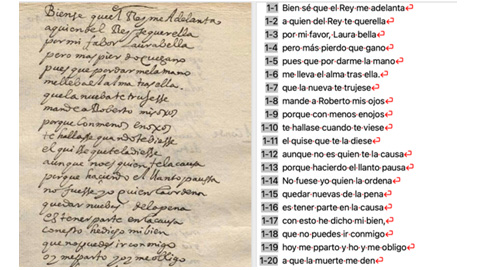Artificial intelligence helps discover an unknown work of Lope de Vega

The Anuario Lope de Vega. Texto, literatura, cultura edited by the UAB's CER PROLOPE research group, has now published the discovery of a new comedy by Lope de Vega, entitled La francesa Laura, discovered in the manuscript collections of the Biblioteca Nacional de España by researchers from the universities of Valladolid and Vienna. The use of computer tools has been essential for its detection, the results of which have been fully supported by philological analysis. The researchers and PROLOPE will soon publish the critical edition of the work together with Editorial Gredos.
01/02/2023
In the past few years, artificial intelligence (AI) has become a highly valued tool in several research tasks and projects. The more rigurous historical-philological research has also benefited from this new type of resource. And proof of that is the case of the discovery of La francesa Laura, an unknown play by Lope de Vega (1562-1635), after an intense work combining the use of advanced computer tools and traditional philological research.
The discovery was made possible thanks to the National Library of Spain (BNE) and its collaboration with the ETSO project "Stylometry and Spanish Golden Age Theatre", directed by Álvaro Cuéllar (University of Viena) and Germán Vega (University of Valladolid), the researchers responsible for the discovery, and which included some 150 collaborators dedicated to the use of computer analysis of theatre literature from the Golden Age to solve problems of authorship; the UAB PROLOPE group, who do the enormous jon of publishing and studying Lope de Vega's work, who provided the texts; the Transkribus tool, which facilitated the preparation of the materials needed for the tests, and the researchers' universities of Valladolid and Viena.
The new comedy can already be viewed on the BNE's Hispanic Digital Library, while the scientific paper on the discovery can be found in the latest number of the UAB journal Anuario Lope de Vega. Text, literatura, cultura, under the title of "La francesa Laura. El hallazgo de una nueva comedia del Lope de Vega último". A revised and annotated edition of the play will be published in the coming months thanks to the Gredos publishing house and the PROLOPE research group.
AI for historical and philological research
The use of AI has been crucial in the discovery of Lope de Vega's relationship with this work. It was preserved anonymously in a manuscript from the end of the 17th century, many years after the writer's death, which is kept at the BNE, along with many other anonymous works, in the institution's very rich collection of theatrical manuscripts. No ancient or modern document, nor any present-day or contemporary Lope de Vega scholar, has so far been able to relate it to who was known at the time as the "Phoenix of Wits".
Firstly, the work was automatically transcribed using AI techniques by means of the Transkribus tool, which allows accurate transcription of ancient manuscripts with a high degree of precision. The machine was trained on some three million correctly identified words, and then processed some 1,300 plays from the Golden Age, both printed and handwritten, which were transcribed in just a few hours.
In a second phase, the works were classified by author, by means of automatic learning processes, capable of classifying works as written or not written by Lope de Vega with more than 99% accuracy, as recent studies have shown. Among the 1,300 automatically transcribed comedies, La francesa Laura was classified as written by Lope de Vega in its entirety. The lexical uses of the work were closely aligned with his own and not with those of the other 350 playwrights of the time who were available in the experiment.
Confirmation by traditional philological studies
After the computer classification of the work, researchers began intense work to determine whether this was truly a comedy written by the distinguished dramatist’s, but this time with the traditional resources of philological research. Among these tests were the study of versification (how Lope used common metrics in his works), orthology (how he pronounced words and used diphthongs, hiatus or synalephas), and especially the study of echoes of Lopesko, that is, the coincidence of both ideas, themes and motifs, as well as specific lexical structures between this work and other texts by the playwright around the time it was written. All of the tests confirmed what was noted in the initial experiments with artificial intelligence: the work fits like a glove into Lope de Vega’s theatrical productions.
First page of the anonymous manuscript La francesa Laura (BNE. MSS/16946).
Digitalised by BNE
http://bdh-rd.bne.es/viewer.vm?id=0000216882
Comedy at the artistic height of Lope’s last stage
According to researchers, everything indicates that this is a new genuine comedy of the playwright, written five or six years before his death. The presence and flattering treatment of the French, which the title already emphasizes, seem to indicate that it was composed during the brief period when the Spanish and French crowns became allies against the English in the late 1620s, putting an end to the tensions between the nations that had marked the Thirty Years' War.
La francesa Laura is a fine theatre play with the dramatic power expected from a mature Lope de Vega. The story is set in France and revolves around Laura, daughter of the Duke of Brittany and married to Count Arnold. The work, although a product of its time, presents from the beginning a strong defense of women, as can be seen in these verses: "Fuera de que a las mujeres/les sobran tantas hazañas/que en las armas y las letras/envidia a los hombres causan".